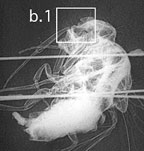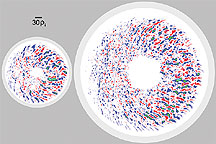How can a little bit of geometry improve microwave cooking? What encouraging news has the largest unclassified supercomputer provided on fusion energy? These and many other questions were addressed at one of the APS's largest physics meetings this year: the 43rd annual meeting of the Division of Plasma Physics (DPP), held from October 29 - November 2, 2001 in Long Beach, California. Almost 1,600 papers were delivered at the meeting, covering a broad range of topics in plasma physics research.
 Intricate details emerge in this radiograph of a fruit fly produced with the flash emitted by an X-pinch plasma. (Cornell University) |
Researchers at Cornell University have used the brilliant burst of x-rays emitted by vaporizing wires to create striking images of tiny subjects, including houseflies and fruit flies. The radiographs help to demonstrate the characteristics of the flash that erupts when 100,000 amps of current are rammed through the crossed wires of an X-pinch machine. When a current courses through X-pinch wires, they vaporize into plasma. The plasma continues to guide the current, which in turn generates a magnetic field that confines the plasma.
As the current increases, the magnetic field grows and the plasma implodes, typically resulting in one or two dense plasma points less than a thousandth of an inch across with temperatures as high as 10 million degrees centigrade. The unstable plasma points first emit bursts of x-rays that last less than a billionth of a second and then explode. Bright, point-source x-ray bursts generated by the X-pinch machine are ideal illumination for radiographs of thin objects. Details on the order of a few millionths of a meter, such as the hairs on a fly's wing, would be impossible to discern with larger x-ray sources, but are clearly visible in images created with X-pinch flashes.
Supercomputer Provides Encouraging News for Commercial-Scale Fusion Reactors Massively parallel simulations at the world's fastest unclassified supercomputer provide realistic assessments of plasma turbulence in large-scale fusion reactors. (Princeton Plasma Physics Laboratory) |
Using the new IBM SP, the world's fastest non-classified supercomputer, located at the National Energy Research Scientific Computing Center (NERSC) at California's Lawrence Berkeley National Laboratory, researchers have discovered that future large-scale fusion reactors may be able to trap or "confine" hot plasma fuel more efficiently than previously projected. The deleterious effects of heat loss resulting from the turbulence within the plasma seem to be reduced as one scales up from present-day experimental devices to a bigger, commercial-reactor-scale machine. Better confinement means that it would be cheaper to operate such a reactor, since less energy would have to be expended to maintain the requisite high plasma temperatures. Alternately, better confinement could enable researchers to build a somewhat smaller fusion device to achieve the same conditions envisioned for a large-scale machine.
The new simulations explore some of the key consequences of scaling up from present-day experimental devices to those of reactor dimensions.
Promising Inertial Fusion Tests at OMEGA
Frozen fusion fuel pellets tested at the University of Rochester's OMEGA laser facility have performed exceptionally well in experiments that will help lay the foundation for future inertial confinement fusion (ICF) research. The pellets are tiny spherical shells less than a millimeter in diameter containing an inner layer of frozen deuterium, which serves as fuel in ICF experiments. To ignite ICF reactions, numerous laser beams directed at a pellet's surface vaporize the shell, compressing and heating the deuterium to the extreme conditions necessary for fusion to begin.
Photonic Crystal Produces Powerful High-Frequency Microwaves
Using metal rods arranged in a specific geometric pattern, MIT physicists have designed a gyrotron, a device that generates powerful microwaves at very high frequencies. Such microwaves could provide more effective long-range telecommunications and improve microwave cooking, since higher-frequency ovens on airplanes could more rapidly prepare food.
The metal cavity in the new device is formed of a "photonic band gap" (PBG) structure consisting of 102 metal rods geometrically arranged in such a way that it lets some microwave frequencies pass through the cavity while a particular frequency is trapped inside. The PBG structure helps in building larger cavities without generating microwaves at unwanted frequencies. In the gyrotron, the PBG structure keeps microwaves trapped at a particular frequency, which builds up their strength just as in a laser. The researchers generated 140 gigahertz (GHz) microwaves peaking at 25 kilowatts of power.
-Ben Stein and James Riordon, AIP Public Information
©1995 - 2024, AMERICAN PHYSICAL SOCIETY
APS encourages the redistribution of the materials included in this newspaper provided that attribution to the source is noted and the materials are not truncated or changed.
Associate Editor: Jennifer Ouellette
January 2002 (Volume 11, Number 1)
Articles in this Issue

